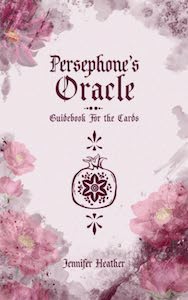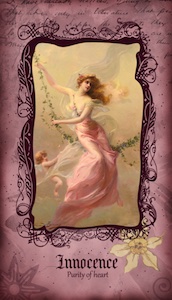
Persephone’s Oracle, by Jennifer Heather
Independently Published, 22 cards, 29 pages, January 2023
Persephone is my goddess archetype, and during the fall, I honor her annual descent into the Underworld to sit on the Iron Throne as Queen of Shadows. As the Sun enters the Venus-ruled sign of Libra, where Saturn is exalted, it is a time for evaluating our relationships and honoring our commitments. I see Persephone as the Virgo Harvest Maiden, led by her psychopomp Mercury into the cavernous Great Below with the Golden Scales of Libra in hand, ready to renew her infernal vows with Hades and share in his judgment of the dead, balancing his Saturnine sternness with her Venusian grace and compassion.
This year, I was thrilled when my Hadean partner surprised me with Persephone’s Oracle as an Autumn Equinox gift. The creator of this deck, Jennifer Heather, is based in the UK and sells this oracle in her ObsidianSirenShop on Etsy. I love supporting Etsy creators, and this deck, as well as her Aphrodite’s Oracle and Hekate’s Oracle, have been on my wish list for a while.
Persephone’s Oracle is a shadow work deck consisting of 22 cards and a slim guidebook devoting a full page to interpreting each one. The entries also include journal prompts to facilitate shadow work and deepen self-knowledge.

In the introduction chapter of the guidebook, creator Jennifer Heather says, “Persephone’s Oracle is symbolic of the journey towards wisdom as experienced by the archetypal maiden descending into the Underworld to face the unknown terror of darkness,”1 and the cards “depict the transition of the maiden to maturity and the lessons obtained along the way.”2 If the cards are read in order, they begin with card 1, titled “Innocence,” relating to Persephone’s beginning as Kore, the innocent Flower Maiden.
The first five cards in the series contain uplifting messages about connecting with your inner child, letting your light shine, and spending more time in nature. The tone shifts with card 6, titled “Surrender,” which speaks of the trauma of Persephone being abducted by Hades in the meadow and carried down into the Underworld, a terrifying ordeal which she had no other choice but to accept. The series continues through various aspects of Persephone’s process of individuation as she is transformed by her journey through the Underworld, and returns to the surface in card 22, titled “Ascension.”
One of my favorite things about Persephone’s Oracle is that the cards are graced with the masterpieces of a variety of famous artists, and the name of the painting, the artist, and the date it was produced is given in the guidebook, so each card is like a mini art history lesson. For example, six cards feature the Art Nouveau paintings of Alfons Mucha, and French Symbolist Odilon Redon’s work appears on four cards. My personal favorite is Proserpine by the Pre-Raphaelite painter Dante Gabriel Rosetti (1874).

I immediately connected with this oracle, and as I shuffled, I asked for a message from Persephone. I felt her gentle, loving energy radiating from the cards. “Cycles” jumped out of the deck, which advised me to “harmonize and flow with life’s rhythm.”3 The painting on this card is Autumn by Alfons Mucha (1896). Autumn is depicted as a nymph with long, flowing auburn hair and a crown of chrysanthemums upon her head. She floats in a vineyard, harvesting grapes. The grape vine is sacred to Dionysos and I see Autumn as one of his female followers, the maenads. I imagine her pressing grapes beneath her bare feet to make wine, the blood of Dionysos. Her flower wreath is significant because the ancient Greeks wore chaplets of chrysanthemums to ward off evil spirits.4
According to Scott Cunningham’s Encyclopedia of Magical Herbs, mums are protective solar flowers associated with the element of fire. He claims that imbibing an infusion of chrysanthemums is a cure for drunkenness. When worn, he says the flowers protect one from divine wrath, and growing mums in the garden repels evil spirits.
I decided to explore the journal prompts in the guidebook by pulling a tarot card for additional guidance. I chose the journal prompt: “In which areas of my life do I resist change?”5 I pulled the Nine of Knives (Nine of Swords) from The Tarot of Vampyres, my current go-to shadow work deck.
The Nine of Knives depicts a moonlit vampire in a torture chamber, holding a dagger and licking blood off her fingers. There are meat hooks hanging on the wall behind her, reminding me of the Sumerian tale of the descent of the goddess Inanna into the Underworld, where she was killed by the Queen of the Great Below, her shadow twin Ereshkigal, and her corpse was hung on a meat hook. The Nine of Knives brings “change through torment” and indicates that “an enemy is projecting their phantoms onto us.”6

Like Persephone, I resist change when an attacker is attempting to force it upon me. I think this is true for most people, because no one wants to be forced to change against their will, but sometimes we can be our own worst enemies. While some cycles, like the changing of the seasons, are a natural part of life, others, like addictions, negative behavioral patterns, and cycles of abuse are meant to be broken, and hitting rock bottom can be a catalyst for positive transformation. Like the Underworld journeys of Inanna and Persephone, a painful change that is forced upon us can liberate us by destroying a false sense of self and initiate our metamorphosis into a new, more empowered and authentic identity.
The chrysanthemums on the “Cycles” card represent protection from evil spirits, the shadowy phantoms that others project upon us. Flower medicine is one of the gifts of Persephone. Pulling these cards prompted me to get a pot of vibrant orange mums for my front porch, and to press a few flowers in my grimoire for future protection spells.
Persephone’s Oracle is an insightful tool for shadow work and self-discovery, and a great complement to tarot. The paintings stimulate the imagination, lending themselves to additional interpretation. Just as Persephone found her latent powers and the hidden aspects of her personality during her dormancy in the darkness, and bloomed with the renewal of spring, we can do the same by embracing the cyclical rhythms of our lives, and the archetypal journey from darkness to light.

Rachel Christina McConnell is a witch, tarot reader, intuitive astrologer, and writing spider. She holds an MFA in Fiction from Columbia University in the City of New York. Her short stories have appeared in Dark Moon Lilith Press and Minerva Rising Press’s The Keeping Room. Links to her publications are available here: https://rachelchristinamcconnell.wordpress.com
